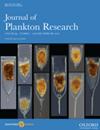Abundance, composition and distribution of carnivorous gelatinous zooplankton in the Northern Gulf of Alaska
IF 2
3区 环境科学与生态学
Q2 MARINE & FRESHWATER BIOLOGY
引用次数: 0
Abstract
Abundance, biomass, size and distribution of macro-jellyfish were measured in the Northern Gulf of Alaska (NGA). Nearly 1000 kg dispersed among ~13 800 jellyfish were collected using a 5-m2 Methot net. We present length-weight regressions for seven most-common taxa. Catches were dominated by the hydrozoan Aequorea victoria and the scyphozoan Chrysaora melanaster. During 2018, epipelagic macro-jellyfish biomass averaged 1.46 ± 0.36 g WW m−3 for July and 1.14 ± 0.23 g WW m−3 for September, while during 2019 they averaged 0.86 ± 0.19 g WW m−3 for July and 0.72 ± 0.21 g WW m−3 by September. Despite similar biomass among seasons within a year, July abundances were fivefold greater than abundances in September, with July catches dominated by smaller-sized jellyfish over the inner shelf, while during September larger jellyfish were more prominent and most predominant at offshore stations. Comparison to 20 years of data from standard towed nets allowed determination of the relative magnitude of the dominant carnivorous zooplankton components: scyphozoans, hydrozoans and chaetognaths in the NGA. The biomass of these smaller epipelagic predators (5.4 mg WW m−3 for hydrozoans and 10.5 mg WW m−3 for chaetognaths) is a low percentage of the macro-jellyfish, despite their much higher numerical abundance.阿拉斯加湾北部胶状食肉浮游动物的丰度、组成和分布
对阿拉斯加北部海湾(NGA)大型水母的丰度、生物量、大小和分布进行了测量。用5平方米的Methot网在约13 800只水母中收集了近1000公斤的分散物。我们提出了七个最常见的分类群的长度-权重回归。渔获量主要为水螅动物维多利亚水螅(Aequorea victoria)和棘螅动物金蛹(Chrysaora melanaster)。2018年7月,上层大型水母生物量平均为1.46±0.36 g WW m - 3, 9月为1.14±0.23 g WW m - 3, 2019年7月平均为0.86±0.19 g WW m - 3, 9月平均为0.72±0.21 g WW m - 3。尽管一年内不同季节的生物量相似,但7月丰度是9月丰度的5倍,7月渔获量以内大陆架上的小型水母为主,而9月大型水母在近海站更为突出和占优势。与20年来标准拖网的数据进行比较,可以确定NGA中主要的食肉浮游动物成分的相对大小:孢子虫、水螅虫和毛囊动物。这些较小的上层捕食者的生物量(水螅动物为5.4 mg wwm - 3,毛齿动物为10.5 mg wwm - 3)在大型水母中所占的比例很低,尽管它们的数量丰度要高得多。
本文章由计算机程序翻译,如有差异,请以英文原文为准。
求助全文
约1分钟内获得全文
求助全文
来源期刊

Journal of Plankton Research
生物-海洋学
CiteScore
3.50
自引率
9.50%
发文量
65
审稿时长
1 months
期刊介绍:
Journal of Plankton Research publishes innovative papers that significantly advance the field of plankton research, and in particular, our understanding of plankton dynamics.
 求助内容:
求助内容: 应助结果提醒方式:
应助结果提醒方式:


